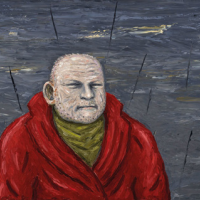21. PETER BOOTH

As a society we happily consign individuals to their broad generational cohort, assuming we all will more or less fit the tag of Baby-Boomer, Gen X, Y or Millennial and, to a great extent, such generalisations hold true. Our opinions and behaviours are shaped and moulded by the broad sweeps of history into which we are born. Peter Booth came into the world at a key moment on the cusp between the generation of the Great Depression and those often described simply as war babies. And for Peter that timing could not have been more telling born in the English industrial city of Sheffield on 2 November 1940, just at the moment it suffered its heaviest air bombardments of World War II. The German bombers were targeting the steelworks and armaments factories along the River Don, but destroyed much of the city centre and surrounding suburbs for good measure. As a toddler and a little boy, Booth knew the bleak reality of a destroyed city, of bombs and air raid sirens, being dragged below to shelter and the meagre fare offered in a constrained home life. Even after the war the food and fuel rationing went on for years and he would experience the deprivation and the overhanging shadow of all the death and destruction that had surrounded his lost childhood. It must have been with great anticipation and hope that in 1958 he accompanied his family to a new life in Australia. By then Peter was a young adult and set to work as a labourer before gaining entry to the National Gallery of Victoria Art School to study painting.
The mid 1960s was a turbulent time in art as it was in the wider society another war beginning to fester in Vietnam and a new, more educated and less compliant cohort of baby boomers leaving school and setting out to change the world. Those artists who had come of age during the war Sidney Nolan (1917-1992), Arthur Boyd (1920-1999) and Albert Tucker (1914-1999) were the new mid-career heroes, leading the charge both at home and back in the United Kingdom where they were beginning to gain international reputations. In Australian art schools there was turmoil and change, with various forms of abstraction and expressionism becoming the dominant forms. The cool hard edge of Sydney Ball (1933-2017) and Alun Leach-Jones (1937-2017) was pitted against the painterly abstraction of Fred Cress (1938-2008), while traditionalists like Kenneth Jack (1924-2006) simply vacated the scene, leaving the space ripe for change. As a young painter Peter Booth took the path of painterly abstraction, producing a series of dark and menacing works of seriousness and gravity. Simple black shapes in heavy impasto were tantalisingly obscure doorways, windows or impenetrable walls, who was to say? The coming to Melbourne of the hugely important exhibition Two Decades of American Painting in 1967 reinforced Booths view of the new art world and his paintings were included in the seminal follow-up exhibition The Field the following year. But there was a limit to how far one could push the black emptiness and Booth began to introduce figures, quickly moving into a form of surreal expressionism that struck a chord with a community seeking a deeper meaning than the refined landscape painting then dominating the market. His cutting-edge art was given free rein in one new Melbourne gallery, Bruce Pollards Pinocotheca, a former shoe factory in Waltham Place in Richmond, opened in 1970. Peter Booth had a number of one-man shows in the cavernous space, a place that allowed him to expand both his vision and the scale of his works. Building on the theme of man in a degraded environment of his own making, Booth rose quickly to a prominent position in the Melbourne art world. His work was never easy, always dark and challenging, and yet appealing in a way that was hard to explain.
Man in a Red Coat has all the Booth hallmarks a seemingly simple image of a rough and weathered character, huddled in a thick red coat. Tough and scarred, could he be a gangster, or maybe just an old bloke trying to keep warm? Is he posed against the sea, rough and stormy in the background, or is it an overcast sky, with harsh rain streaking down? But the most telling and disturbing element is the sheer scale of the work. Our anonymous old chap is presented many times life-size on a canvas almost two and a half metres wide, a huge brooding visage impossible to ignore. And that is the key to Peter Booths work; paintings which are at once disarmingly simple yet unfathomable in the depth of their intent and meaning. Never easy or comfortable, they leave us contemplating not just a dark world, but our own precarious place within it.
Gavin Fry